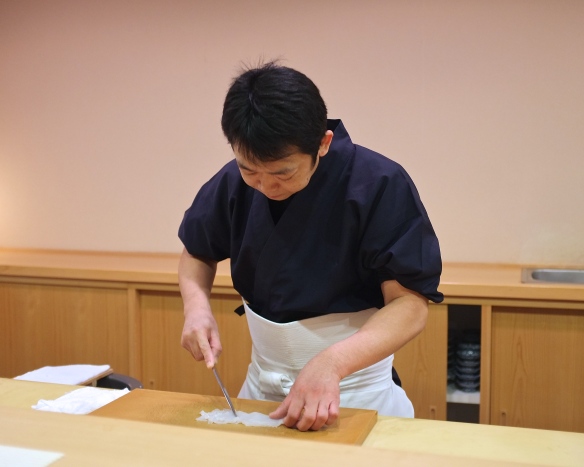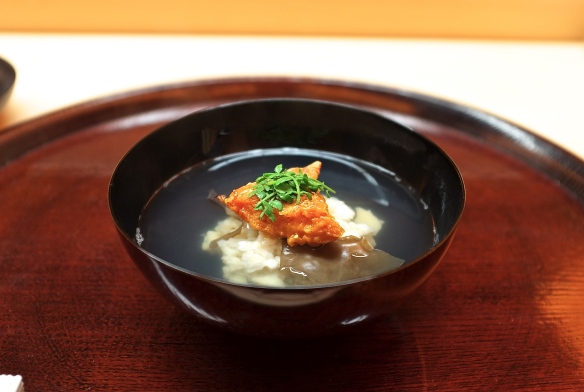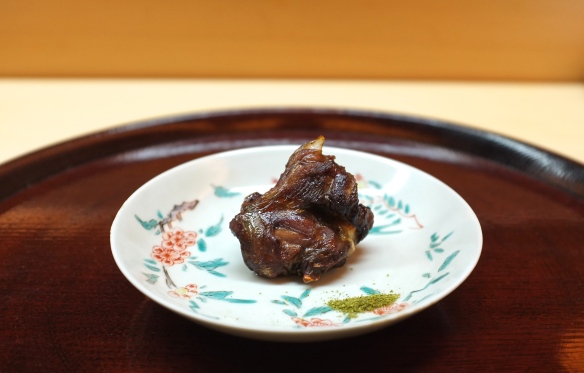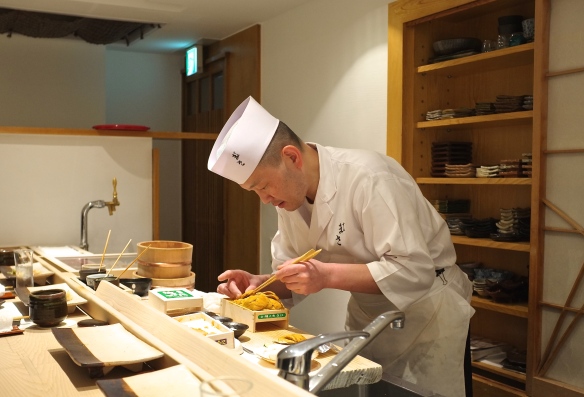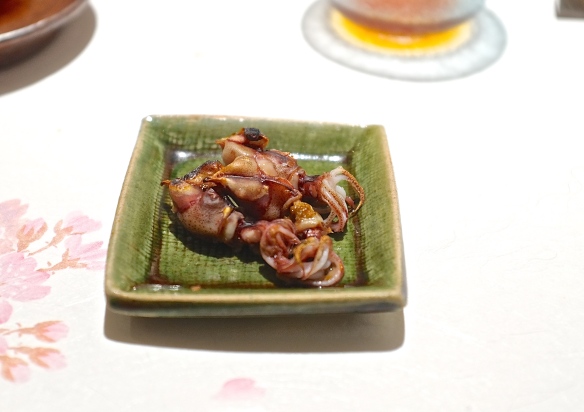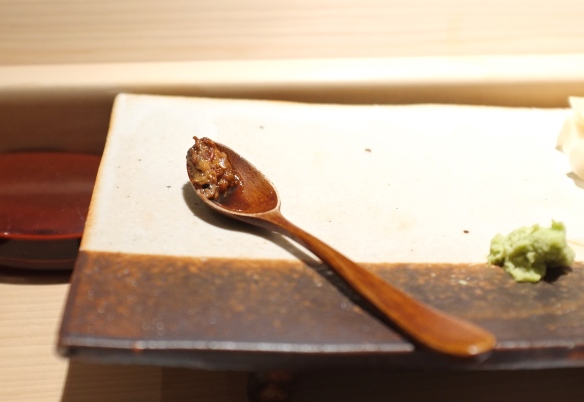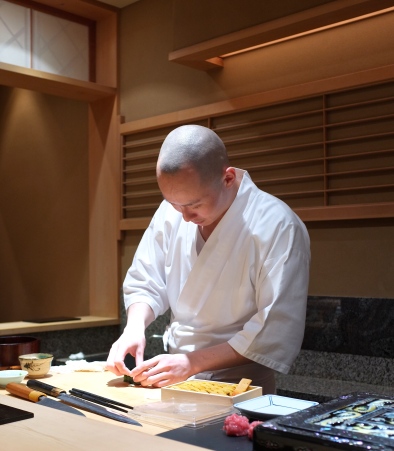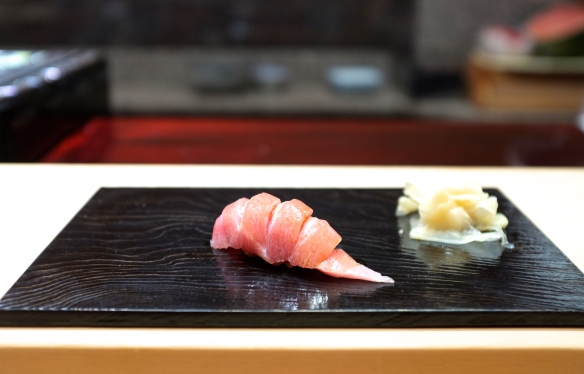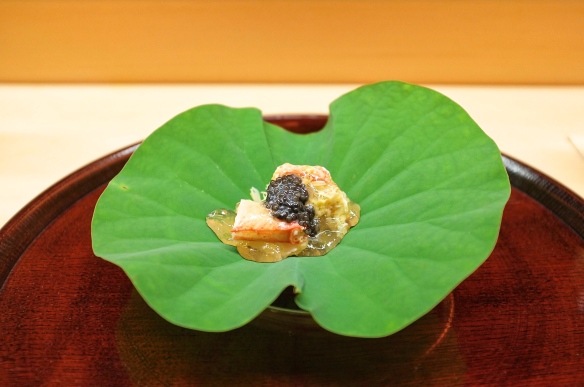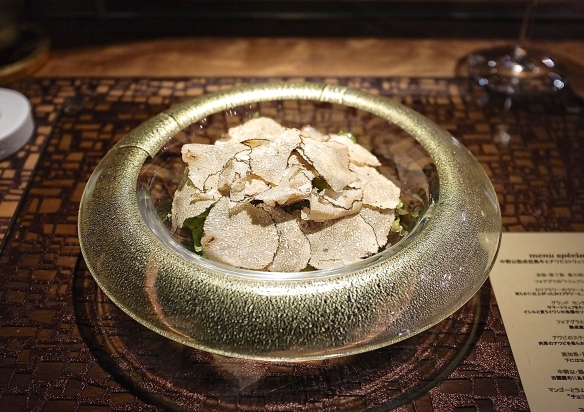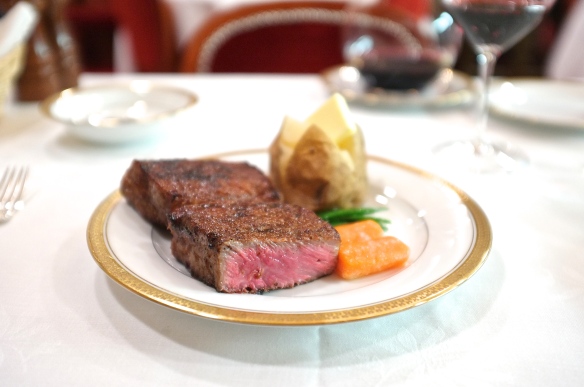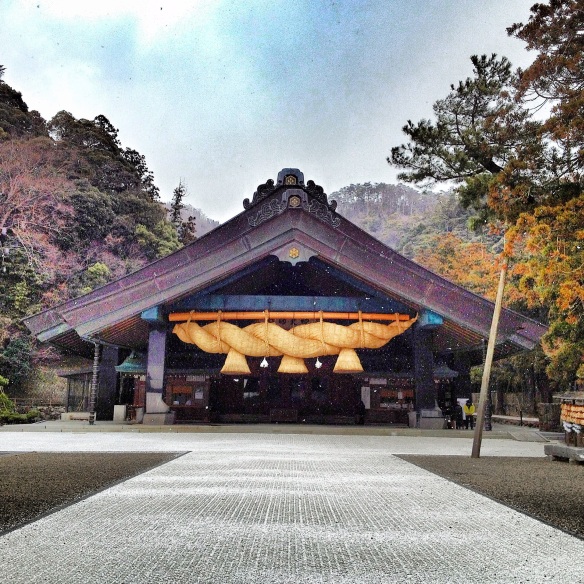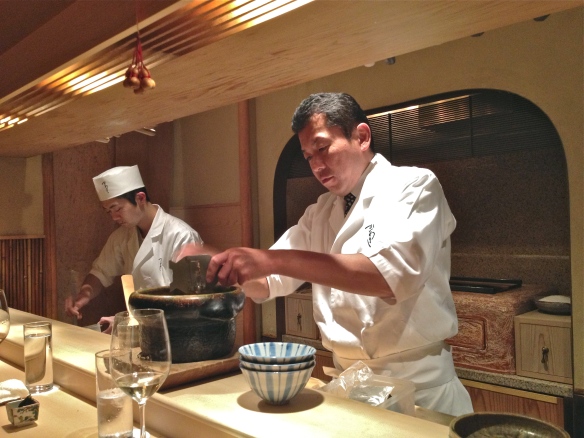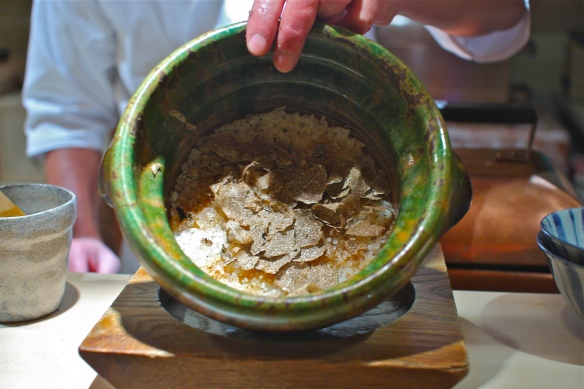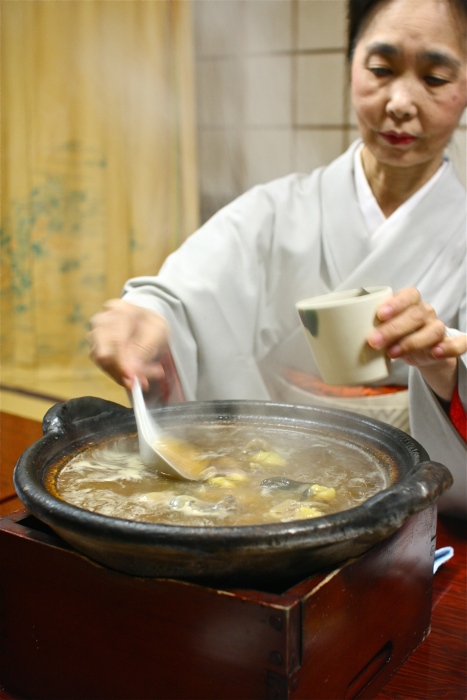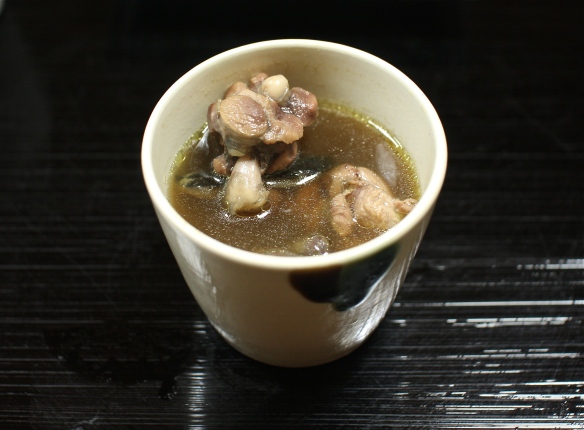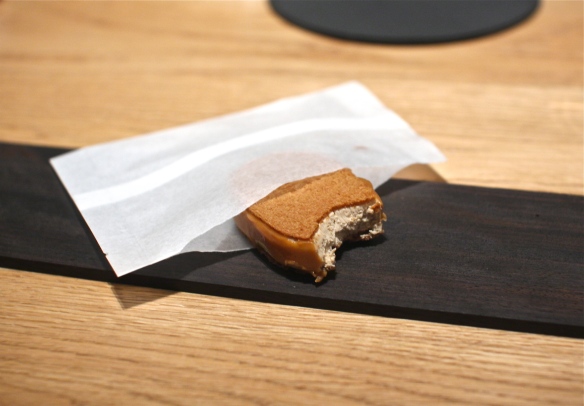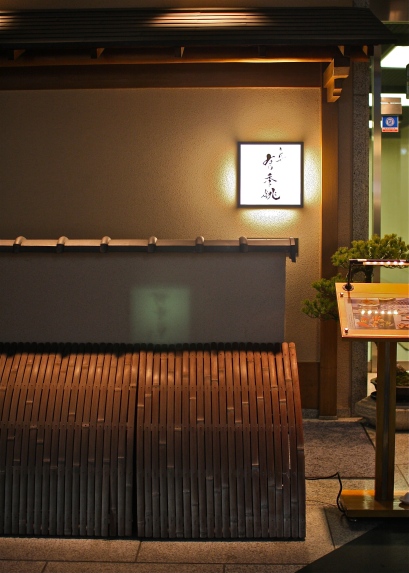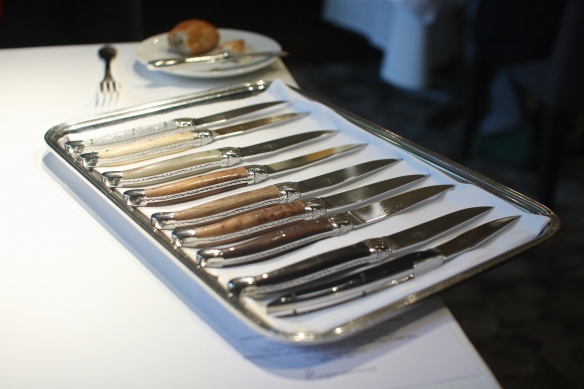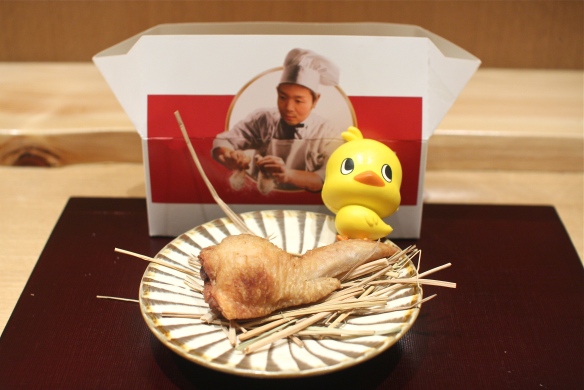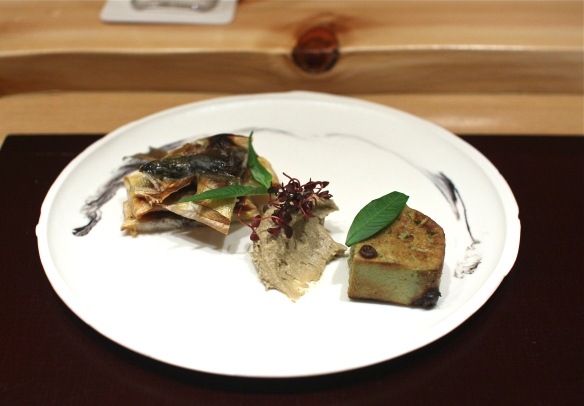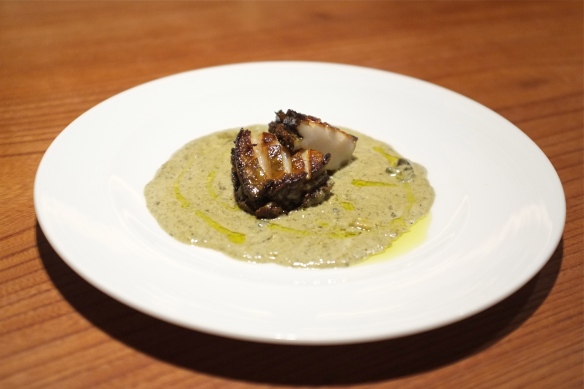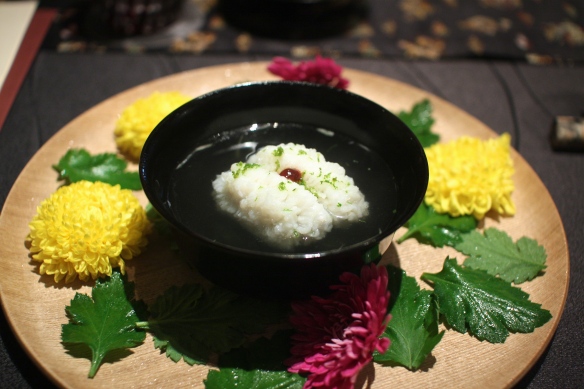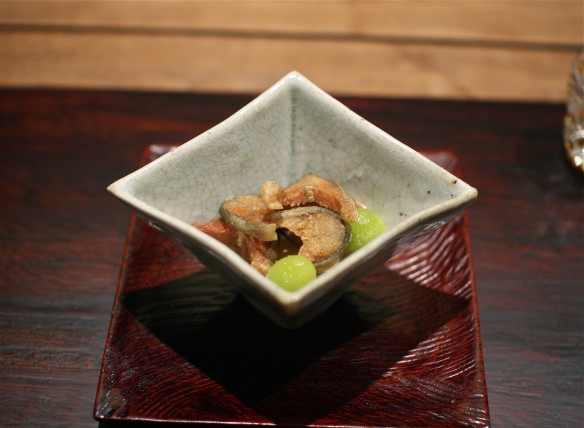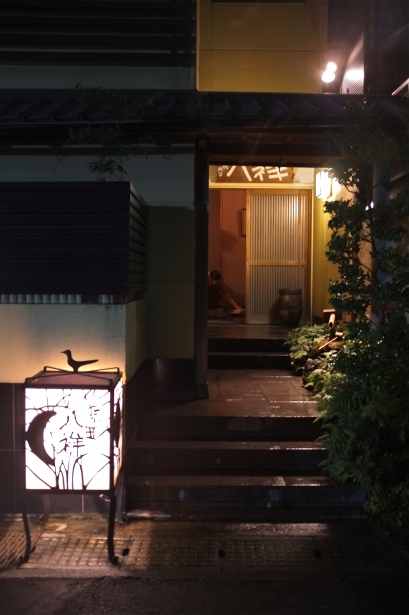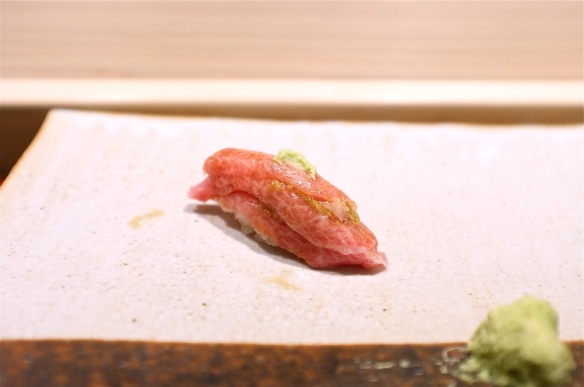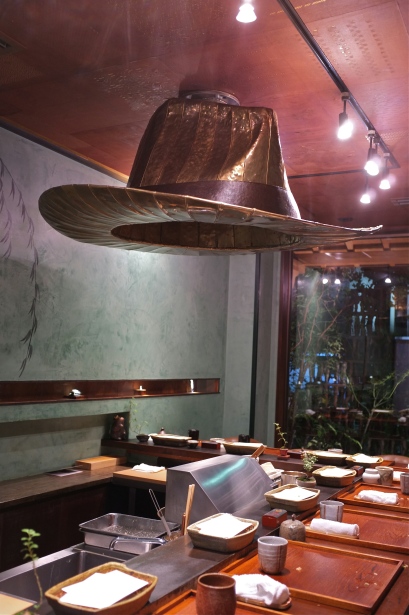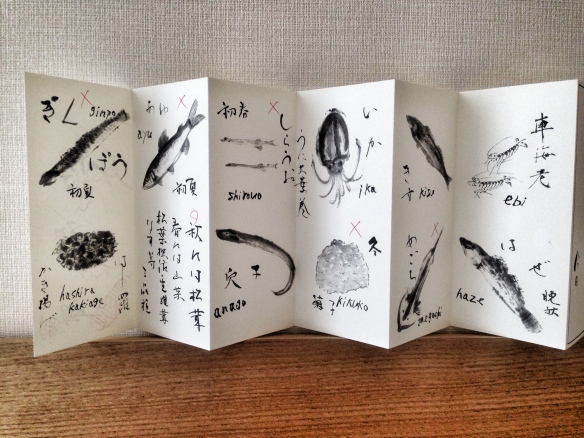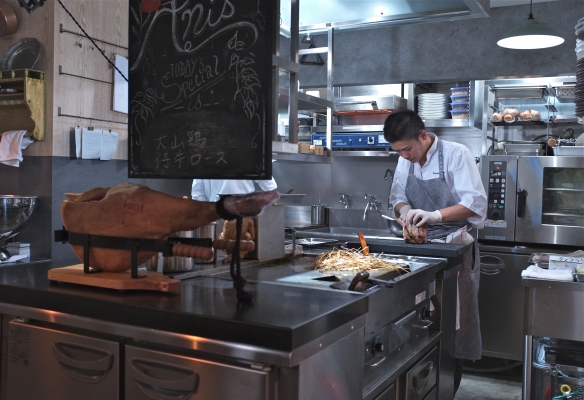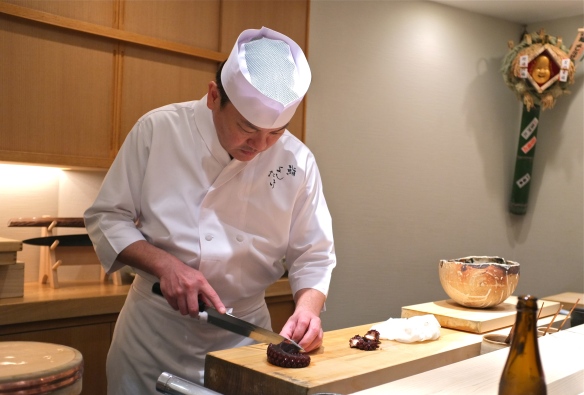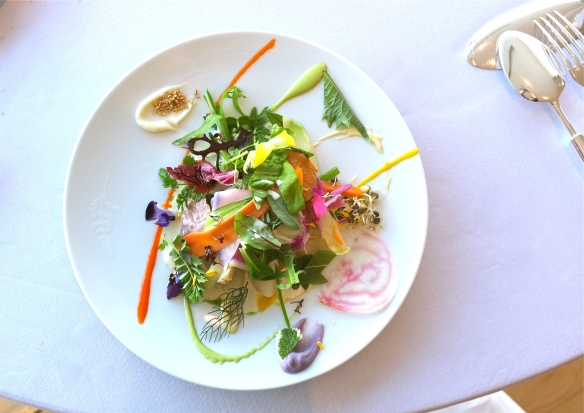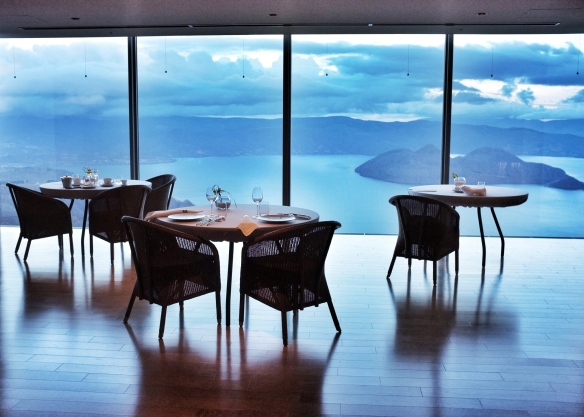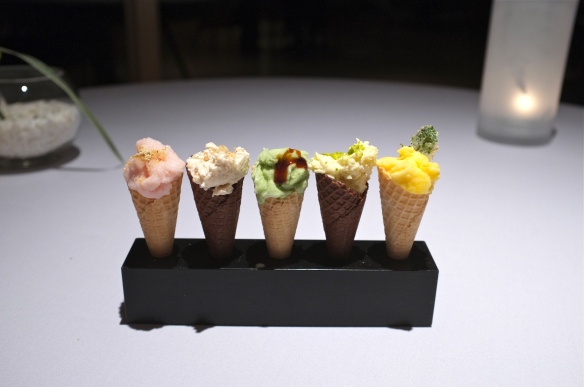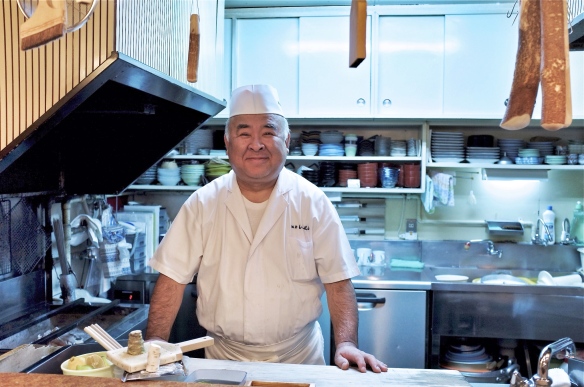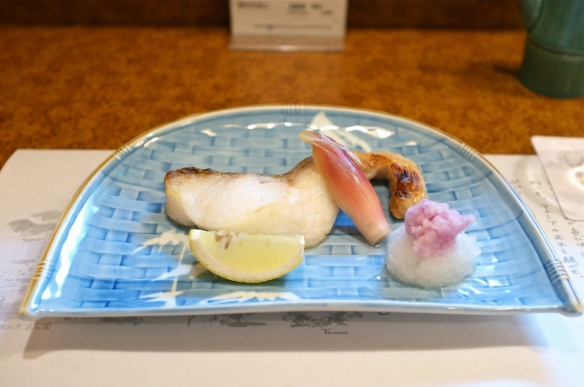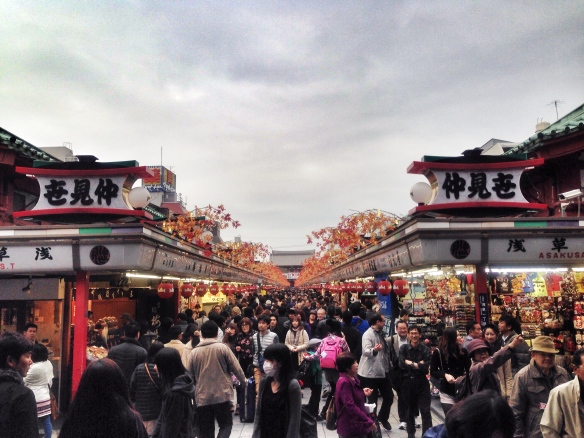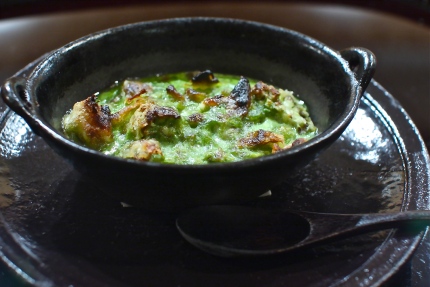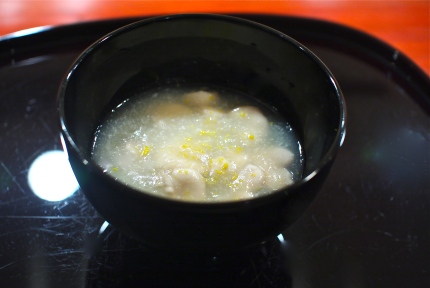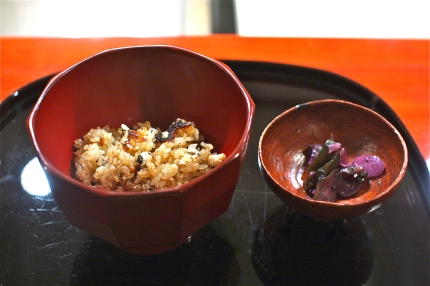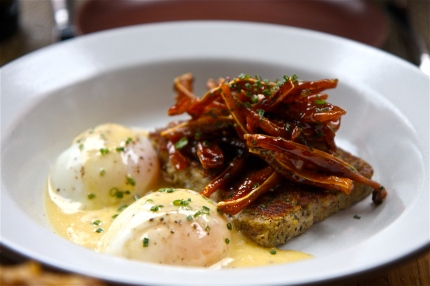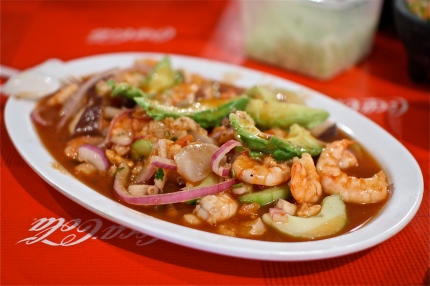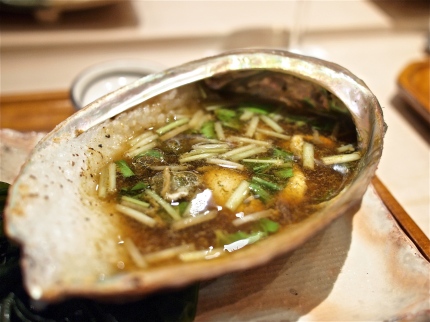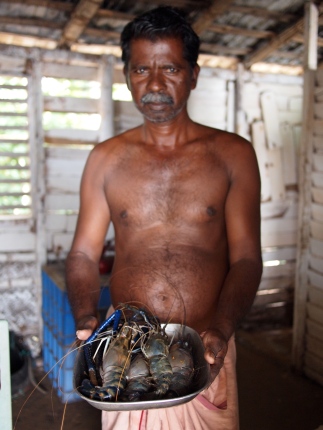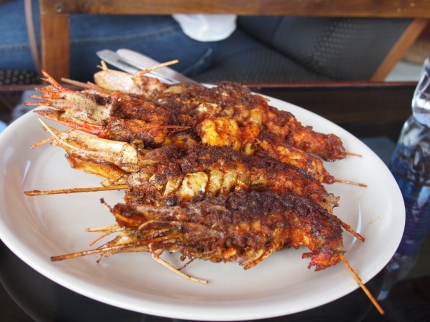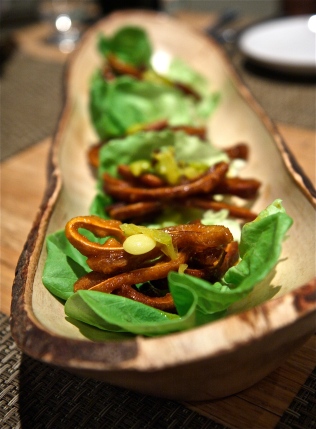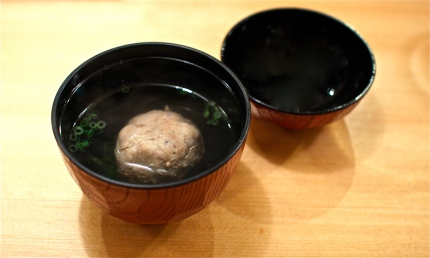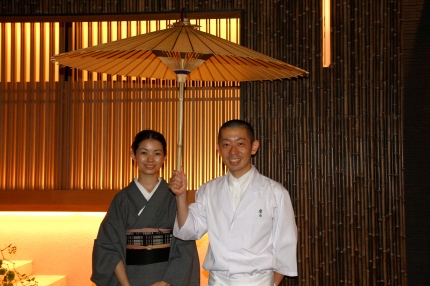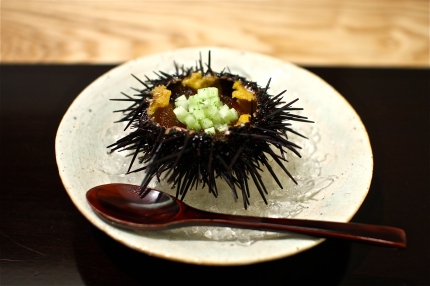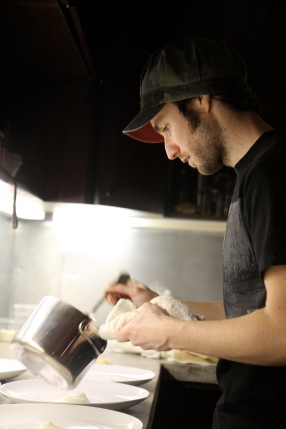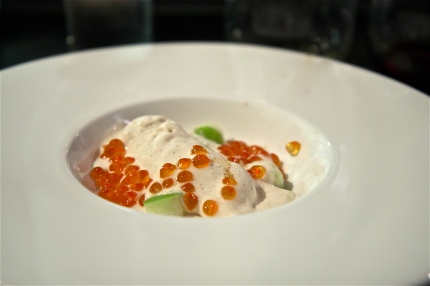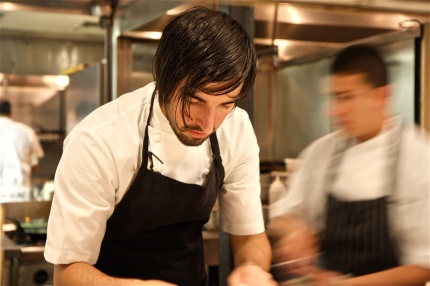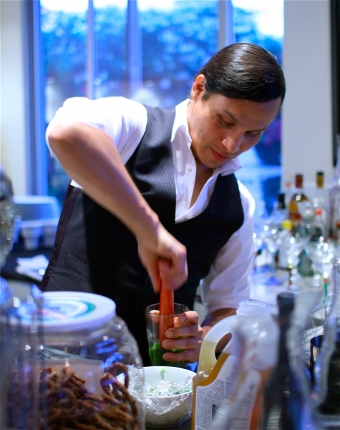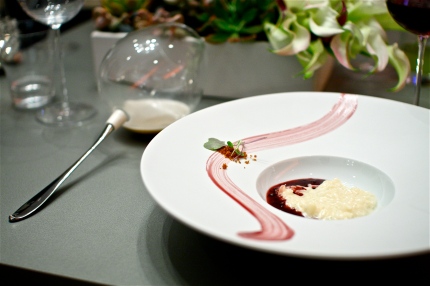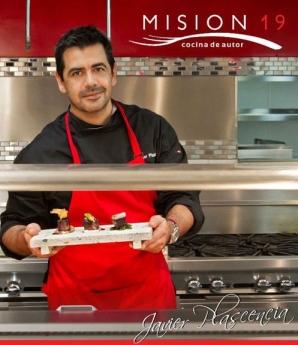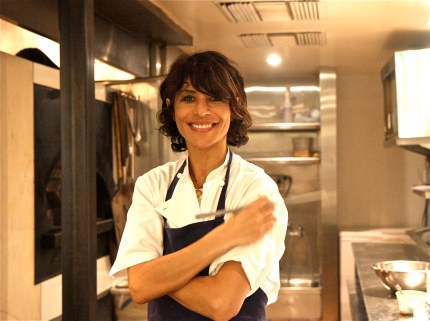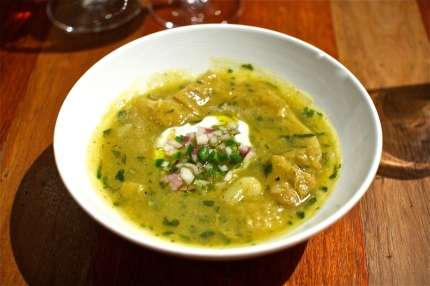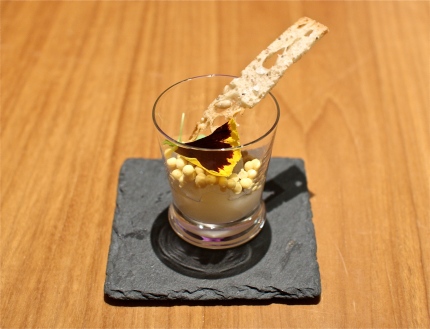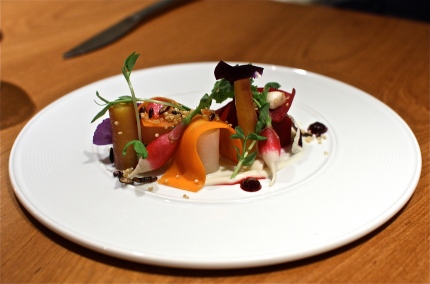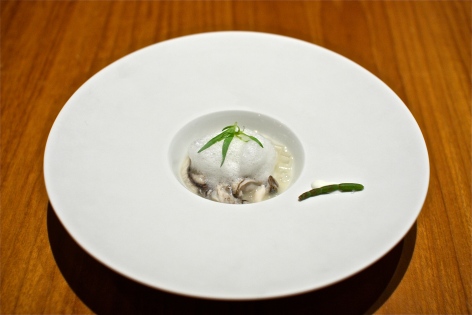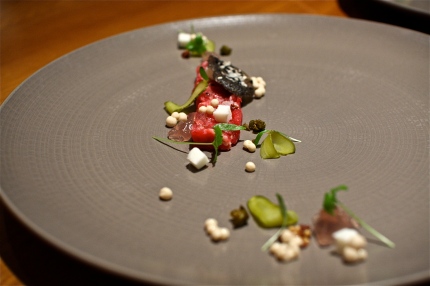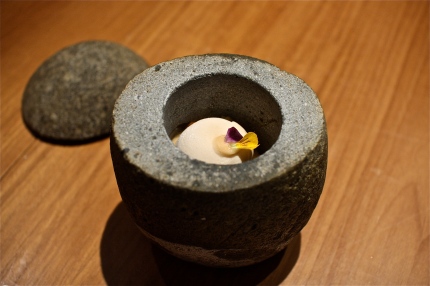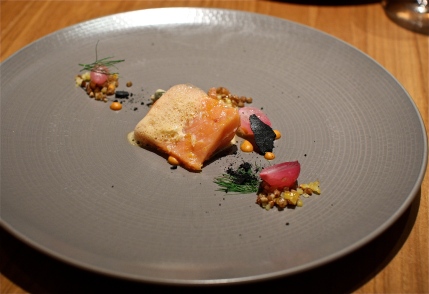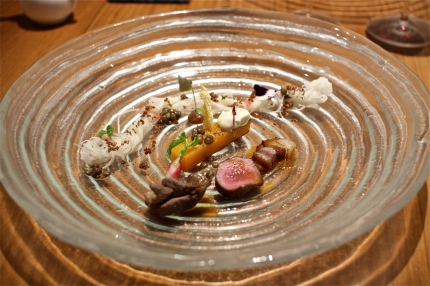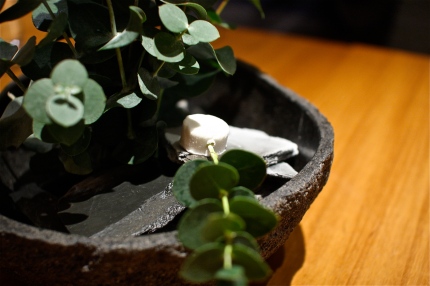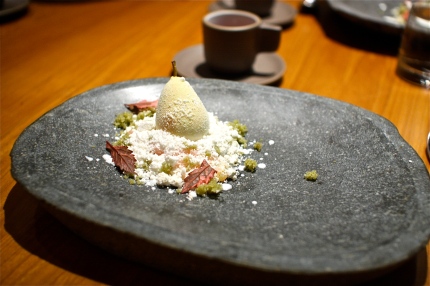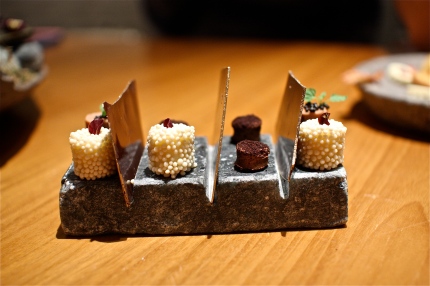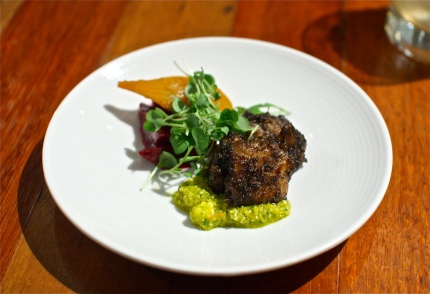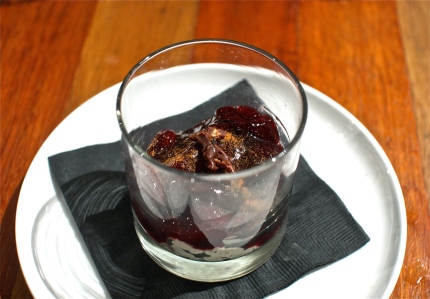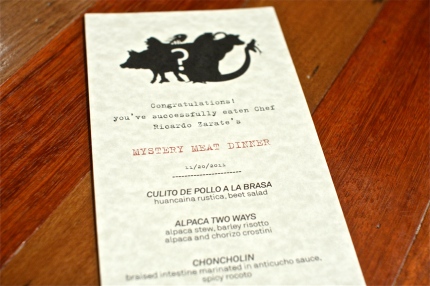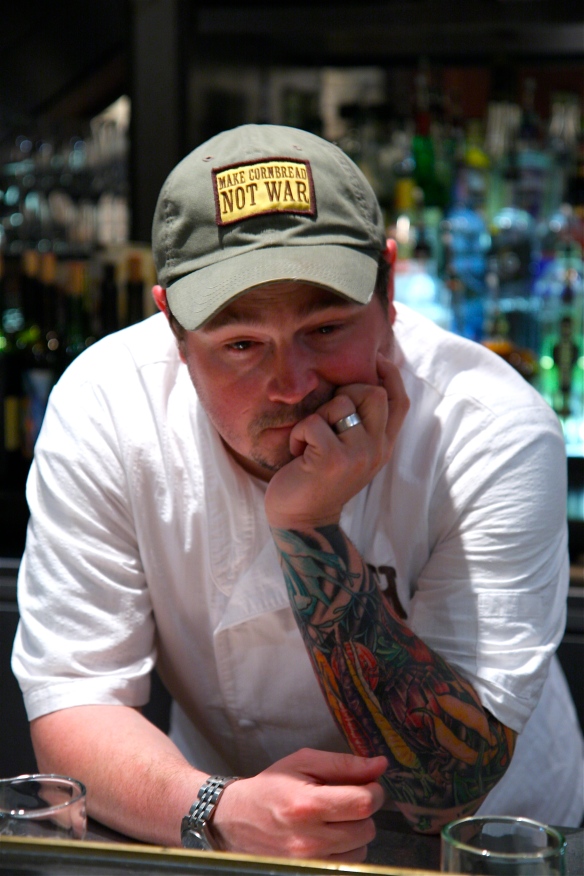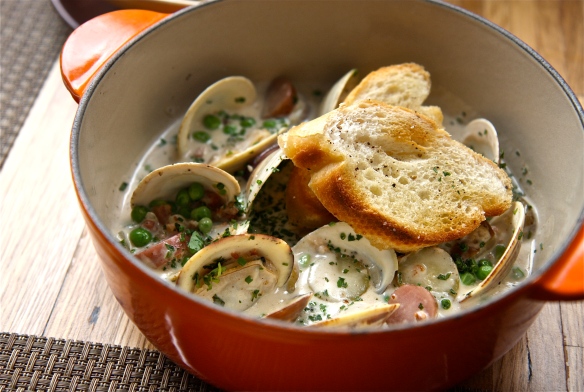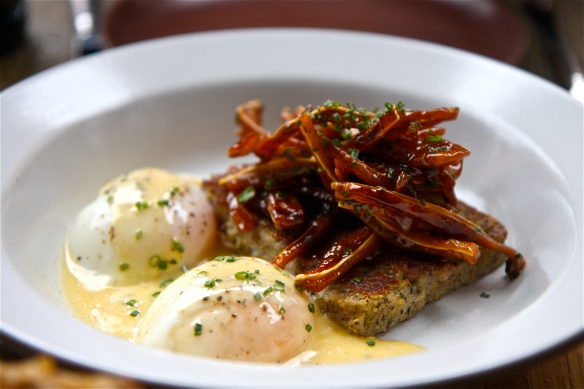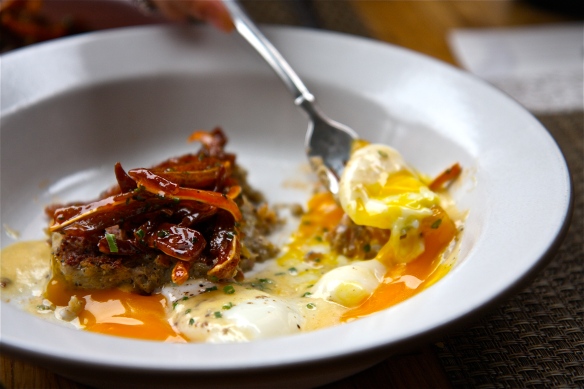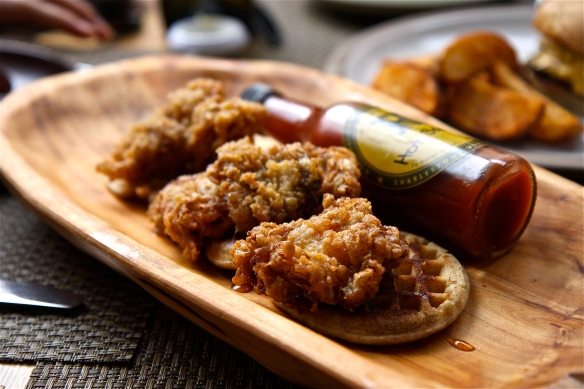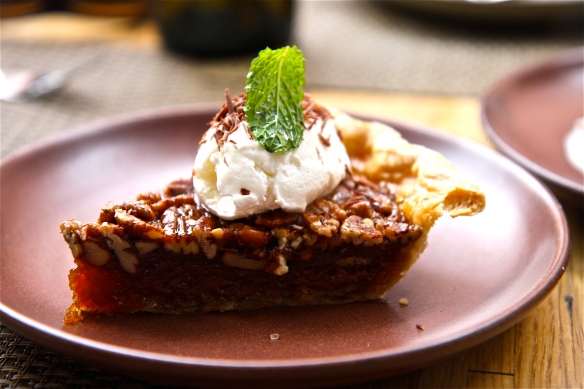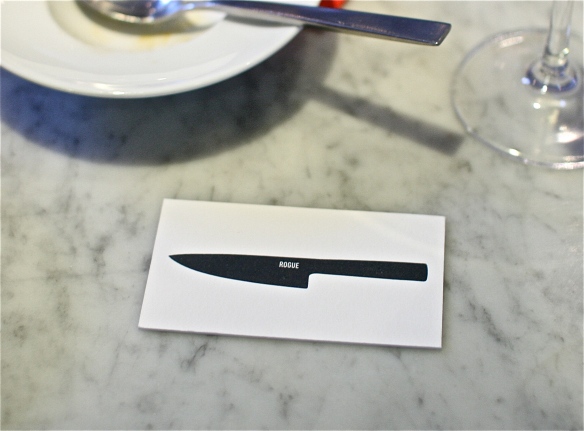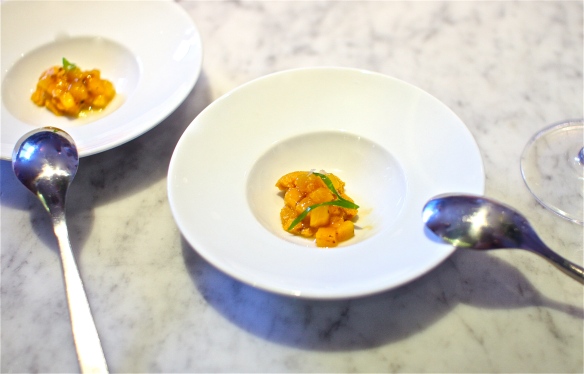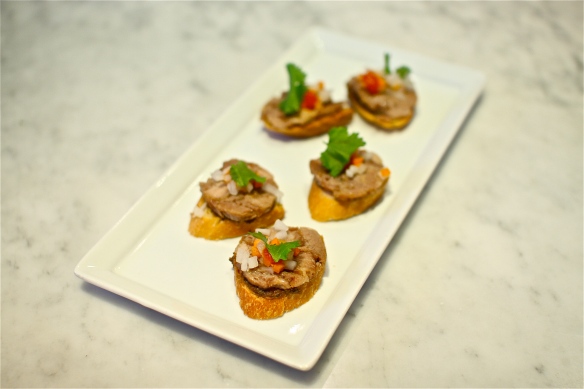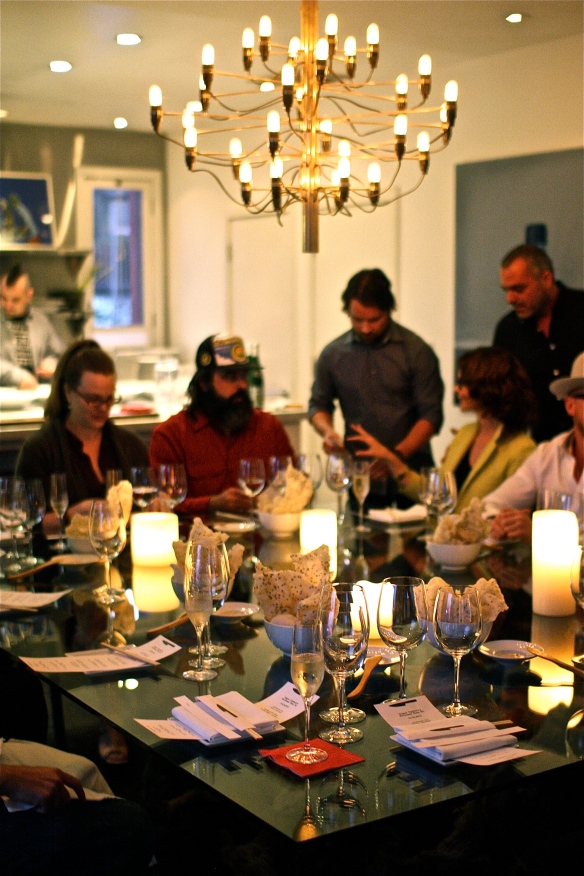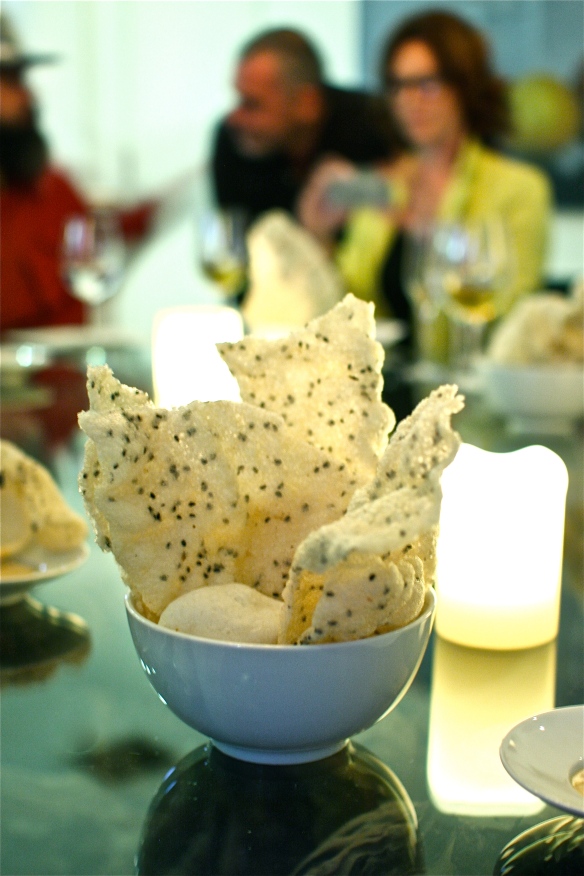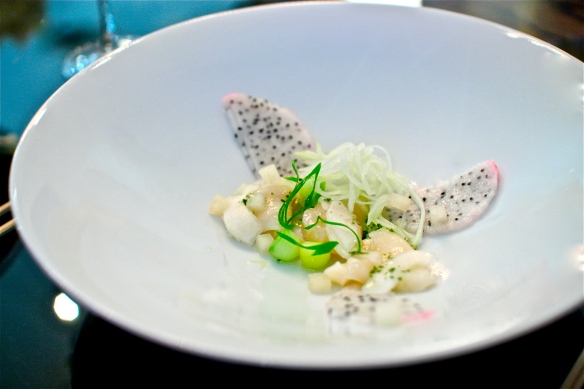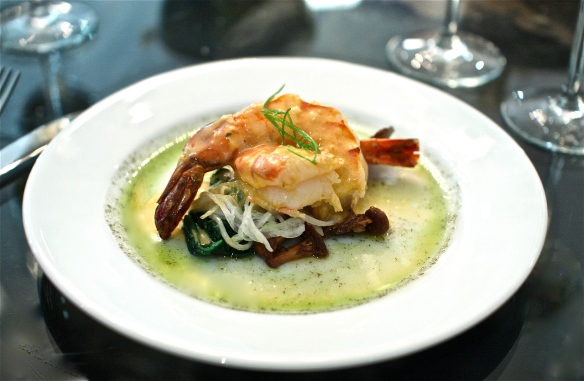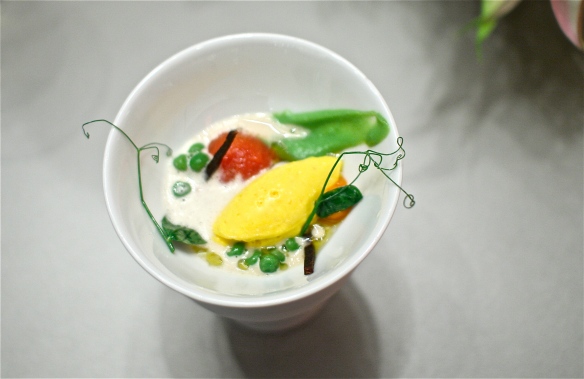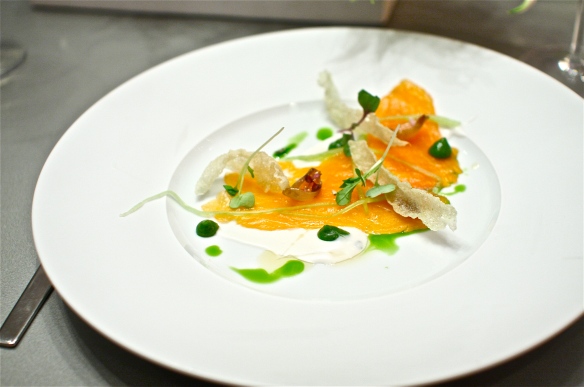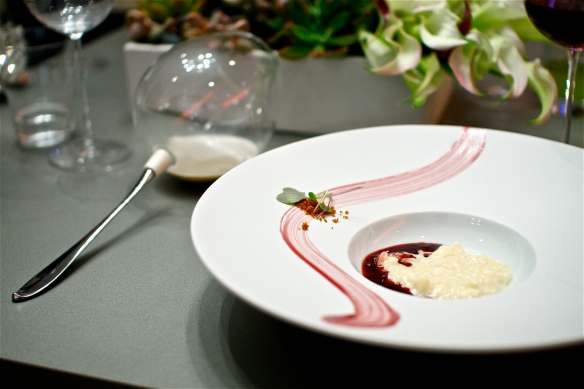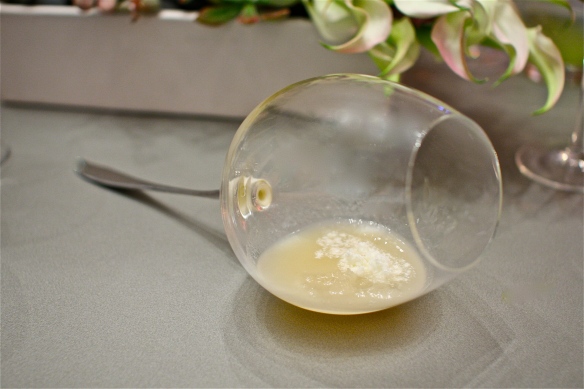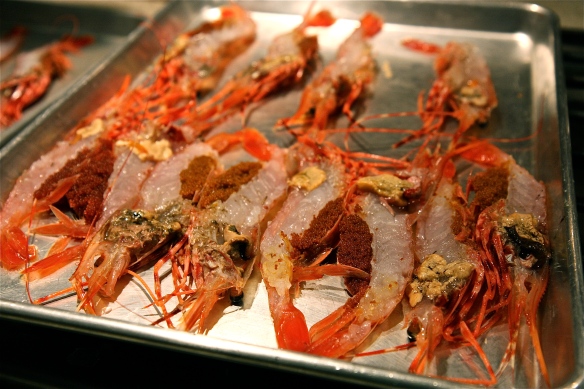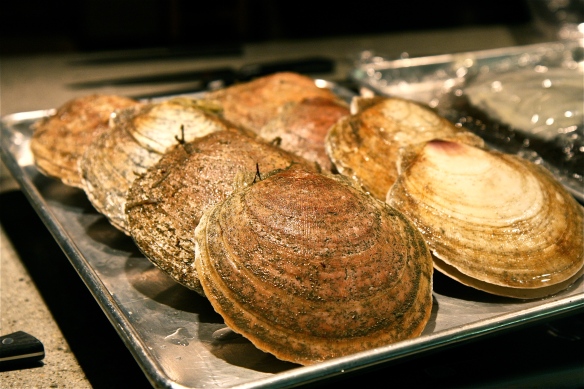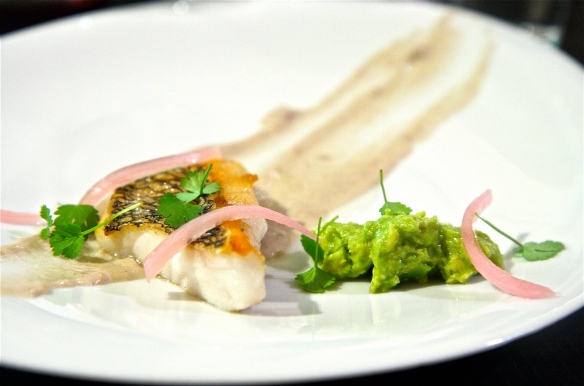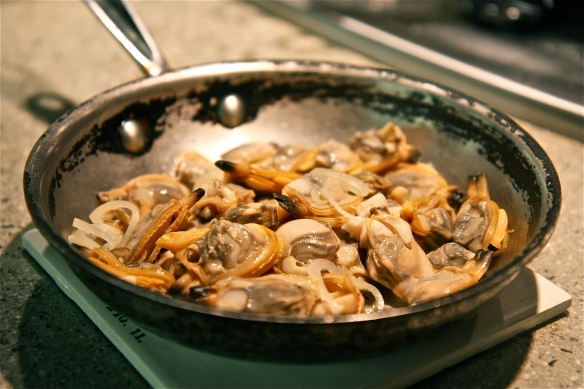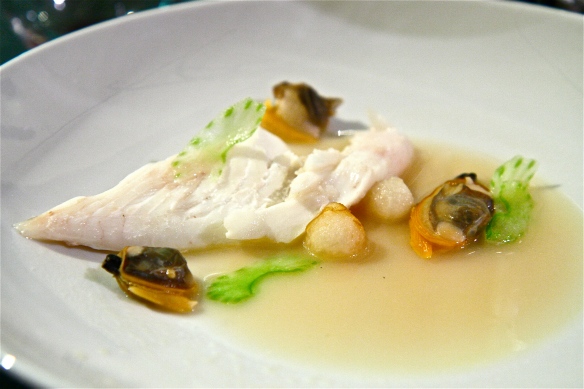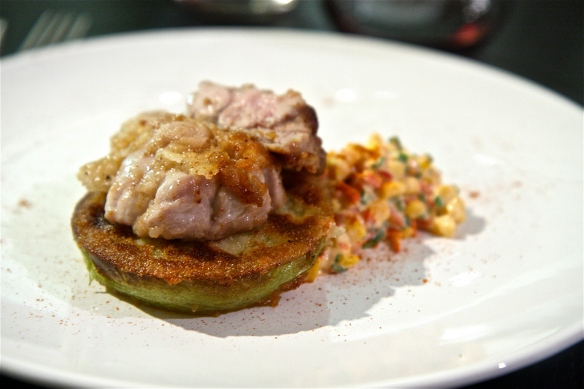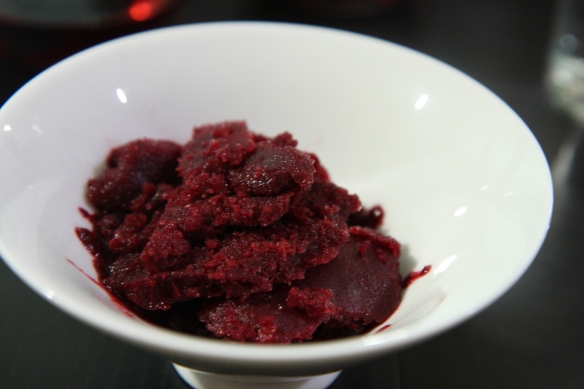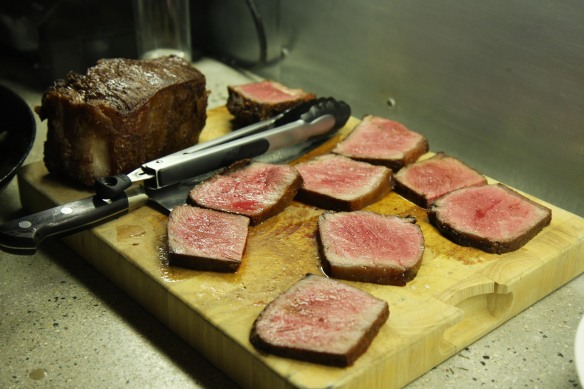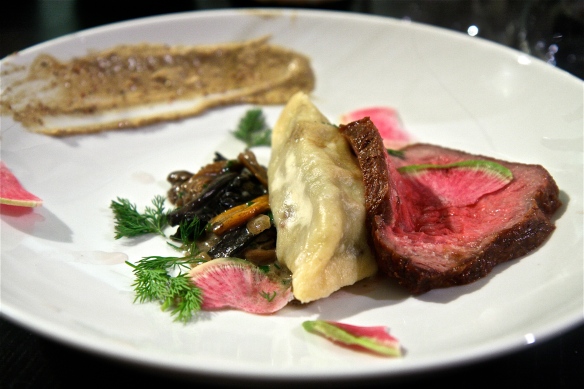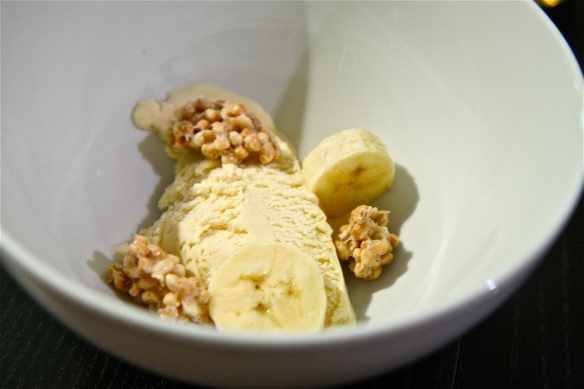2014 has come and gone in the blink of an eye- so fast and so packed that it seems like just yesterday that I browsed through millions of photos of sensational dishes that I ate in 2013 for my previous post. Now, having come full circle, I reflect on 2014, the most fruitful year with respect to dining. 2014 took me through the liveliest pintxos bars in San Sebastián, exclusive wine cellars in Bourgogne, foie gras stores in Budapest, oyster shacks in Boston, late night bistros in Paris, bakeries in San Francisco, ramen stalls in Tokyo and fish markets in Reykjavík. I tasted some of the freshest seafood on the western coast of Japan, alive and kicking just minutes before emerging as a bite-sized piece of pristine sushi. I experienced theatrical presentations and whimsical creations of food (lights, camera, action) in some of the world’s finest Michelin-rated establishments in Basque country. I was introduced to local delicacies in Iceland- hákarl, for one, which is putrid ammonia-rich fermented shark meat, not at all kind to the olfactory or gustatory nerve endings. I ate more than my life’s share of lobster rolls in Maine and Massachusetts, and even more cheese throughout my travels in France. There was an abundance of fresh anchovies to keep me content. And there was a lot of wine in 2014, from the finest magnums of Côte d’Or to my favorite Riojas and Jerez sherries.
Choosing my most memorable dishes from this incredibly fulfilling year of wining and dining was no simple feat. There were, quite literally, hundreds that pleased my palate, invoked new ways of appreciation for the culinary arts and brought me closer to those who I shared these memorable meals with. Given that I spent most of the year- winter, spring and summer- eating through Japan, it is only appropriate that I start there.
Japan offers no paucity of spectacular dining options, from casual izakayas and hole-in-the-wall udon shops to the world’s most illustrious and renowned fine dining establishments. Many friends came to visit last year and I enjoyed introducing them to my culture and sharing Japan’s seasonal and regional delights. There were many outstanding meals that were not recorded on camera- some happened too unexpectedly, a last minute decision to sneak into a tiny sake bar in a hidden alleyway or a home cooked meal by a friend’s relative. Some were deliberate- the no-photography policy at the newly re-opened L’Osier in Ginza, for one, has left me to relive one of the best classical French meals I have ever had through stored memories of beautiful dishes, the lavish decor and thoughtful service at this restaurant that deserved 3, not 2, Michelin stars.
A special note too to the bars in Japan, a blend of old-school establishments where seasoned veterans make precise gimlets and a budding mixology scene where young talents use vaporizer guns and rotary evaporators to concoct playful and fantastical cocktails. The coffee culture has also seen an explosion in Japan last year, with more and more establishments roasting and brewing their beans in-house. Within a span of a couple of subway stations, you can find your preparation of choice- from the nel drip and aeropress to the elaborate Steampunk.
Here is my selection of the most sensational dishes I had in Japan in 2014- just a mere glimpse into all that Japan has to offer- in chronological order to reflect the seasonality of the cuisine.
HAMAGURI CLAM DASHI, SHIRAKO, CAVIAR- SUSHI MITANI 三谷 (TOKYO)
Sushi Mitani in Yotsuya is my favorite sushi restaurant in terms of quality, flavor combinations, presentation and thoughtfulness. Young Mitani san is quite the magician in extracting the purest flavors of seasonal delicacies and transforming them into beautiful and delicious tsumami, or appetizers. He begins each meal with a parade of rare delicacies- often outnumbering the number of nigiri sushi that follows- and that is what I love the most about dining here. He may drizzle a sauce of sea urchin and scallop innards over barely seared Hokkaido scallops. He may serve tender steamed abalone in a soup made from sea cucumber ovaries and abalone extract. Winter is the best time to visit Mitani, when fish are at their fattiest and their innards have reached their peak flavor profiles. On my last visit, the stand out dish was this marvelous creation of black and white- a velvety smooth and rich cream made from hamaguri clam dashi and sweet shirako (cod milt), topped with luscious pearls of Kazakhstan’s finest caviar.
Sushi Mitani has some of the most impressive sake selections in Japan to complement each stage of culinary bliss. The only problem is getting a reservation. The first time I went, 4 years ago, I had to wait 6 months for my reservation. Subsequent wait times grew longer and longer, and my most recent reservation, which I booked over a year ago, had to be passed on to an eager colleague due to a scheduling conflict. I want to believe that the experience is well worth the wait, but who wants to wait a year?
SCALLOP SPAGHETTI- TAKAZAWA (TOKYO)
Chef Takazawa takes center stage in this open kitchen that looks out onto the intimate dining room that fits just 4 lucky parties a night. Liquid nitrogen smoke and spherification pearls are usual players in his contemporary style cuisine, which adds to the theatrical feel of the restaurant. It’s the type of fun meal that stimulates great table conversation and creates lasting memories. The scallop spaghetti was a real joy- long white noodles made entirely of scallops, its bouncy and slippery texture evoking intense delight, topped with sweet succulent sea urchin. He is set to open a new bar this week called Takazawa Bar just across the street, which is sure to be a new popular destination.
MAGURO NIGIRI- KOMATSU YASUKE 小松弥助 (KANAZAWA)
Almost every sushi chef that I have ever talked to has told me that their dream is to travel to Kanazawa to eat at Komatsu Yasuke, where 83 year old sushi legend Kazuo Morita still, to this day, runs a full house. Many sushi chefs have called him the greatest sushi shokunin (artisan) of all times, stating that a visit to this holy temple of sushi is on their bucket list. It had been on my bucket list for some time too, and 2014 was the year to make it happen.
Starting this spring, there will be a new direct bullet train line connecting Tokyo to Kanazawa, which is on the western central coast of Japan. Until then, it will take a couple of transfers to get there. The legendary restaurant is nothing like I had anticipated. It is located in the lobby of a business hotel, and the servers are middle aged housewives wearing aprons and slippers. But the magic is definitely there, happening behind the sushi counter. Morita makes every piece of sushi with precise and calculated movements, single-handedly serving an entire counter full of diners and a 4 top table in the rear in a smooth uninterrupted orchestrated flow. Cut, squeeze and dab, his seasoned hands never stop moving, all the while maintaining conversation with each diner while calculating his next move. It is mesmerizing to watch and his creations are worth the pilgrimage. Maguro zuke, tuna briefly marinated in soy, is served with a splash of sweet citrus- his signature style of Kaga sushi that brightens the flavors of the fish and fills my palate with lovely aromas.

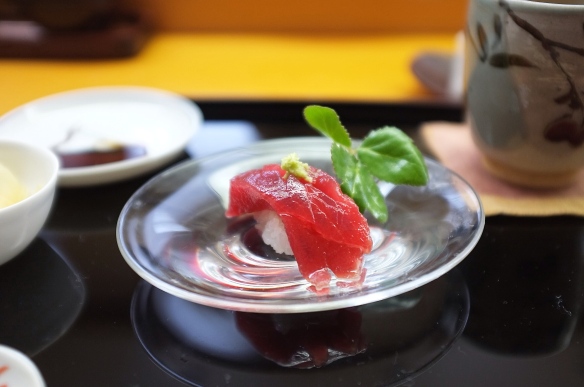 GASU EBI NIGIRI- SHINOSUKE 志の助 (KANAZAWA)
GASU EBI NIGIRI- SHINOSUKE 志の助 (KANAZAWA)
Legendary sushi shokunin Kazuo Morita (above) has trained many in his career, and one of his most distinguished pupils owns a sushi restaurant called Shinosuke in the same city. The ambiance here is much more quiet, intimate and peaceful, owing to the minimalist interior and the fact that there are only two people running the place- the chef and his wife. The experience here is more contemplative and introspective. There is no external stimuli- just the chef and his fish (much more in tune with what I seek of a sushi experience).
Gasu ebi, or humpback prawn, are a local delicacy only caught in Toyama and Ishikawa prefectures. They are finicky crustaceans that are known to spoil easily, so you’ll never find them outside of these two prefectures. The plump flesh have a brown color that isn’t quite appealing to the eye, but an incredible sweetness that goes beyond any other crustacean that I’ve ever sampled.
SAGAGYŪ BEEF RICE WITH YOUNG BAMBOO SHOOTS- DEN 傳 (TOKYO)
Chef Zaiyu Hasegawa of 1 Michelin star Den in Tokyo is no stranger to my list of yearly sensational dishes lists. His humorous contemporary interpretations of kaiseki keep getting more clever, as the flavors continue to impress. On one of my many meals there in 2014, he served this exceptional beef and bamboo shoot rice dish that still elicits a strong Pavlovian response. Thinly sliced marbled Sagagyū beef is layered over rice that has been steamed in a donabe pot with young bamboo shoots and beef fat. The beef is brushed with a mixture of soy, katsuo dashi and kombu dashi, then broiled ever so briefly. The savory beef fat makes the surface of each rice kernel glisten, gently coating them with its essence. The young bamboo shoots, a signature early spring delicacy, impart a nice crunch for textural contrast. Every bite is fragrant. Every bite simply melts. It is even better the next day as onigiri rice balls- your left overs, made with love and packed in a tiny little take home bag for you when you leave.
HOTATE SCALLOP SHINJO, KONOKO, KINOME- MATSUKAWA 松川 (TOKYO)
We all have that one restaurant that we hold to the highest standards. Matsukawa, the exclusive introduction-only restaurant in Tokyo, is just that for me. The level of professionalism, the supreme quality of seasonal ingredients, the precision of techniques, flawless execution and gracious hospitality demonstrated by all staff epitomize the very intention and culture of kaiseki. I had 4 fantastic meals at Matsukawa through 3 seasons last year, and each one was more impressive than the last. In the spring, I had this fluffy hotate scallop shinjo (dumpling) topped with a wedge of intense konoko (sea cucumber ovaries) and a heap of piquant kinome leaves. Konoko are sea cucumber ovaries that are extracted, salted and dried in the sun (removing the ovaries can be done without killing the animal). The ovaries are carefully layered and sun dried, often resulting in a flat and hard wedge. Here, I experienced a fluffy thick morsel of konoko, unlike anything I’ve had before, in the most breathtaking dashi that was pure, clean and elegant.
GRILLED SUPPON WITH SANSHO- MATSUKAWA 松川 (TOKYO)
Another beautiful spring dish that was served at Matsukawa was this charred bone-in suppon (snapping turtle) thigh meat. Suppon is traditionally served in stews. It was the first time that I had one grilled. The meat was unctuous and tender, with the perfect degree of char on its surface. What really sold me was the savory turtle fat- so light that it left no residue on my palate, yet mind-blowingly juicy and sweet.
WAGYŪ SIRLOIN SHABU SHABU, TURNIP, DAIKON- ISHIKAWA 石川 (TOKYO)
Ishikawa, a quaint kaiseki restaurant in the heart of Kagurazaka (my old neighborhood), is the place that is nearest and dearest to my heart. It goes without saying that it is, in quality and service, one of the best restaurants in Japan. It has maintained its 3 Michelin star status for many consecutive years, and the proof is in every meal that I have had there. What makes it special is the chef, Hideki Ishikawa, who is the most friendly, personable and honest individual, loved not only by all of his regulars, but also his dedicated and loyal staff. His integrity, grace and radiance translate directly onto each plate- his food is a true reflection of his artistry- and I leave every meal feeling enriched and happy. On one of many meals there, this remarkable owan course of braised turnip and grated daikon mizore captivated. Thin slices of buttery wagyū sirloin were draped over the braised turnip, slowly cooking in the warm vapors of the hearty daikon broth.
GRILLED HOTARU IKA (FIREFLY SQUID) & ITS GUTS- SUSHISHO MASA すし匠まさ (TOKYO)
One of the spring delicacies that I look forward to the most in Japan is hotaru ika, or firefly squid. These deep-sea creatures migrate to the surface by the millions once a year for the spring mating season, congregating to one area on the western coast of Japan, in Toyama Bay. At night the entire bay lights up in a radiant display of bright cobalt blue due to its bioluminescence, a spectacle that I hope to witness some day.
During this season, hotaru ika can be found on virtually every kaiseki and sushi menu in the country. I certainly had my fill during the March and April months, but I will always remember how Chef Masakatsu Oka served them at his 7 seater sushi bar in Tokyo. He simply grilled the tiny squid on aluminum foil over flames- upon the first bite, there was a delightful bitterness from the innards, followed by a delicate sweetness from its flesh. Then, he presented a wooden spoon with its melted guts that spilled onto the foil when the squid were grilled. This tiny little spoonful contained the most concentrated essence of firefly squid- a rich extract of splendid umami.
SUPPON (SNAPPING TURTLE) NECK MEAT, LIVER AND UNFERTILIZED EGGS- IFUKI いふき (KYOTO)
It was difficult to choose just one representative dish from what was one of my best meals of the year at 1 Michelin star Ifuki in the Gion district of Kyoto. Charcoal grilling is the signature style of kaiseki here by Chef Norio Yamamoto who controls the embers and flames with seasoned flare. Every course, whether it be the otsukuri sashimi dish or the rice dish, is graced by the binchōtan coals. He controls the hot coals to give just the right amount of influence on each dish, whether it be a slight kiss of smoke to impart a lingering fragrance, or a bold char to flavor his proteins. Suppon (snapping turtle) neck meat, its liver and a cluster of yellow unfertilized eggs were gently roasted over scarlet embers and adorned with a generous shaving of fresh horseradish that, surprisingly, mellowed when paired with these luscious morsels. From beginning to end, my meal at Ifuki was one of the most honest, thoughtful and beautiful meals that I have had in a long time, and one that I hope to relive soon when I return to Kyoto.

 PASSION FRUIT SORBET WITH SUNTORY VSOP BRANDY- KICHISEN 吉泉(KYOTO)
PASSION FRUIT SORBET WITH SUNTORY VSOP BRANDY- KICHISEN 吉泉(KYOTO)
There were only a handful of disappointing meals in Japan last year that fell short of my expectations, and Kichisen, a 3 Michelin star kaiseki restaurant in Kyoto, was one of them. It was a grandeur experience, in true Kyoto style- a 1,400 square foot private tatami room all to ourselves, with every course served in the finest lacquerware and ceramics. There was no soul in each course though, and both the room and the meal felt very distant and impersonal. The dessert course was absolutely charming, almost making up for the lackluster dishes preceding it. Tart passion fruit sorbet was served with a side of Suntory VSOP brandy, to fill into our sorbet cup liberally and generously. Who knew that these two paired so wonderfully and deliciously well? It is a flavor combination that I must recreate at home.
CHARCOAL-GRILLED SEA BREAM & KINKI FISH- TAIAN 太庵 (OSAKA)
Sometimes a perfectly grilled piece of fatty fish is all that you need. At 3 Michelin star Taian in Osaka, that was the highlight of the kaiseki meal. For the last course, Chef Hitoshi Takahata allowed us to choose our protein to have grilled over binchōtan charcoal. We skipped the beef and pork and went for two types of fish- tai (sea bream) and kinki fish. The perfect sprinkle of salt. The impeccable char. Wonderfully crisp skin. We enjoyed both filets down to its very last morsels, until every fiber of flesh was stripped clean off the bones. All that remained were the bones, the fins and our satiated appetites.
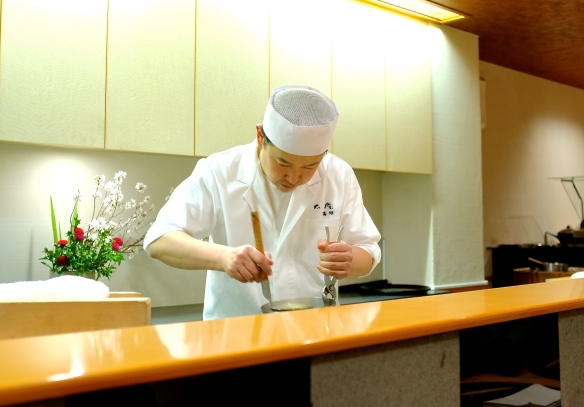
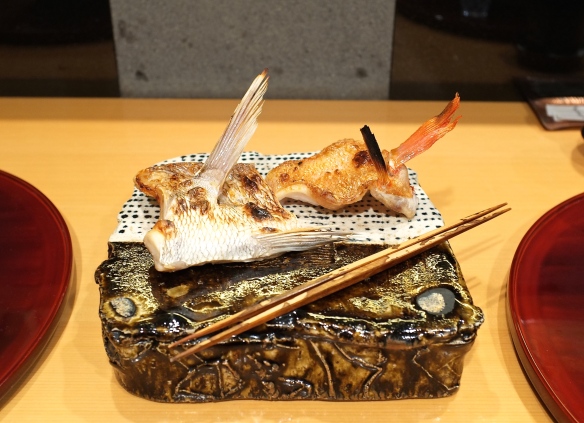 56 DAY AGED MEKAJIKI (SWORDFISH) NIGIRI- SUSHI KIMURA すし喜邑 (TOKYO)
56 DAY AGED MEKAJIKI (SWORDFISH) NIGIRI- SUSHI KIMURA すし喜邑 (TOKYO)
I got to explore many sushi restaurants during my long stay in Japan last year, and discovered new techniques and styles through various talented chefs. One of my favorite establishments is 2 Michelin star Sushi Kimura, a little gem tucked away in a residential neighborhood in the suburbs of Tokyo. Here, third generation sushi chef Kimura san specializes in aging his fish, at times coaxing out its best flavors by simply resting it overnight, and at times transforming them into completely new flavors by pushing the limits on how long he can age them for. Every piece had a story- a distinct beginning, middle and end- a well orchestrated beautiful progression of flavors. Once he served me this 56 day aged swordfish, a bite that exploded with a multitude of intense flavors (hints of coffee, chocolate and even hops), complexities of sweet aromas and ended with a delightfully clean finish. Sushi has reached new heights and possibilities at Sushi Kimura.
CHŪTORO AND ŌTORO NIGIRI- SUSHI TOKAMI 鮨とかみ(TOKYO)
Another new favorite is 1 Michelin star Tokami in Ginza, housed in the same location where the famous Sushi Mizutani first started off. Chef Hiroyuki Sato, who opened Tokami over a year ago, used to work at a beef and tuna specialty restaurant in Azabu Juban. He understands tuna like no other. He is, in my eyes, a tuna whisperer.
Akami, chūtoro, ōtoro. No matter which lean or fatty cut of tuna he serves, it is prepared with incredible attention and deliberation. It is said that the most important aspect of a nigiri sushi is the shari rice, and how it balances with the fish. It wasn’t until I had Chef Sato’s tuna nigiri that I finally understood and appreciated this delicate balance. The pristine piece of tuna from Sado Island, draped over akazu vinegar rice, was truly the perfect bite. When I pointed this out to him, he smiled, and revealed that as a tuna specialist, this perfect balance was exactly what he had been striving for. Consequently, the anago (salt-water eel) that he serves at Tokami is the best anago sushi that I have ever had. He is also an eel whisperer.
WILD CAUGHT GRILLED UNAGI- GINZA OKAMOTO 銀座おかもと (TOKYO)
The best quality seasonal ingredients, grilled under expert hands, will almost always please me. At 2 star Ginza Okamoto, Chef Hidetsugu Okamoto served this wild caught unagi (freshwater eel) from Okayama prefecture, a truly rare delicacy these days given the threat of extinction to the species. Grilled over binchōtan to the most incredible finish- a delightful crispiness on its skin while retaining its plump moist texture inside- and sprinkled with accents of kinome leaves, this was remarkably delicious, and nothing like its farm-raised counterparts.
KUROBUTA PORK PROSCIUTTO, KŌJI MARINATED CHICKEN- CHATEO AKUSAN チャテオあくさん (HIROSHIMA)
One of the meals that I enjoyed and learned from the most was at Chateo Akusan in Hiroshima, a small family-run operation where the father and daughter do the cooking and the son runs the front of house. They experiment with aging, fermentation and smoking, transforming and creating new flavors that push the limits of food. The course started with a smidgen of 3 year fermented oyster topped on a soft-boiled egg. It was intense, pungent and wonderful. Then there was kōji marinated milk skin and smoked grapes. What blew me away was this charcuterie course, starting with Kurobuta pork prosciutto, 6 month air-dried Hiroshima jidori chicken breast, and little chicken liver nuggets marinated in kōji for 3 months, then smoked. Every bite delivered a concentrated punch of intense flavors that I have never experienced before in my life. It was at once novel, fun, eye-opening and exciting- a meal of new discoveries and new horizons.
HAMO (PIKE CONGER) & ROE RICE- SEIZAN 晴山 (TOKYO)
The rice course at the end of every kaiseki meal is something I always look forward to. It is a comforting way to end a meal, and the contents of the rice course often feature seasonal ingredients. The one at Seizan was by far one of my favorites of 2014, with summer hamo (pike conger), hamoko (pike conger roe), ginger, shiso, sansho and nori. The little beads of hamo roe coated each grain of rice, imparting a delightful crunchy texture to each bite. The flavors, reflecting Seizan’s style, were simple, light, pure and restrained. It was summer heaven in a warm bowl of steamed rice, in all its purity and glory.
HOKKAIDŌ KEGANI (HAIRY CRAB), CAVIAR, YUZU GELÉE- MATSUKAWA 松川(TOKYO)
Summer at Matsukawa proved to be just as magnificent as spring, with this handsome dish of sweet Hokkaido kegani (hairy crab) with luscious creamy Kazakhstan caviar and yuzu gelée. Kazakhstan caviar, also served in the first dish in this post at Sushi Mitani, is unlike any other caviar. The pearls are larger, the skin is softer, the eggs are less salinated and the texture is creamier. Paired with sweet crab meat and finishing with bright citrus notes, this was a sensational representation of Chef Matsukawa’s artistry.
GRILLED AYU- ISHIKAWA 石川 (TOKYO)
Summer transitioning into early autumn is Japan’s peak ayu season, where every restaurant celebrates this mild flavored river fish. I had a lot of ayu during the 2014 season- it is usually grilled and eaten whole- but Ishikawa perfected it. Swimming in the tank until they’re ready to be scooped out and cooked, these little fish are skewered in a way that makes it look like they are still swimming. While most restaurants grill ayu over high heat, Chef Ishikawa grills them over low heat, from charcoal, for 20 minutes- slowly and ever so patiently. This way he has more control to obtain that perfect crispiness on the surface while retaining the moisture inside the delicate flesh. Dipped in green tade herb sauce and eaten from head to tail, this was the best ayu I have ever eaten.
SUMMER TRUFFLE SALAD- MORI (TOKYO)
A pile of summer truffles so massive that you can’t even see the green lettuce salad underneath? I will eat this any time, any day. This dish of salad greens dressed in sardine fish sauce and covered with copious amounts of thinly shaved summer truffles was a demonstration of purity and simplicity (but certainly not restraint). Mori, a relative newcomer to the Tokyo dining scene, is one of the few places in Tokyo where you can enjoy such delicious decadence with Chateau D’Yquem at a reasonable price. The 2003 Sauternes was paired with foie gras, roasted porcini and aged Kurobuta pork consommé, another stellar course at Mori.
SHINKO NIGIRI- SUSHI IMAMURA 鮨いまむら (TOKYO)
Shinko (young gizzard shad) season lasts only for a few short weeks in August. During this month I combed through many sushi restaurants in Tokyo, in pursuit of these tiny little delicacies as small as my fingertips. I had many wonderful versions at many fine establishments, but the one at Imamura was my favorite. A lot of work goes into preparing these finicky little fish- one chef told me that 5 little pieces take up an hour’s worth of prep time. Depending on the size of the fish, there may be anywhere from 4 to 10 layered filets for each bite of sushi. They must be gutted, deboned, salted and marinated in vinegar to just the right timing- under marinating will cause the fish to spoil, while over marinating will degrade it into an acidic mush. The stars aligned at Imamura and this one bite, consisting of 4 perfect filets, was sensational.
SANDA WAGYŪ SIRLOIN STEAK- ARAGAWA 麤皮 (TOKYO)
Japan is known for its marbled wagyū beef, a genetically superior breed of cattle that produces some of the most buttery cuts of meat in the world. At the old-school Aragawa steakhouse, only prize-winning Sanda wagyū cows make the cut, slowly roasted by hand over binchōtan charcoal by a seasoned chef. We tried two strips of sirloin from two different Sanda cows- one more marbled and fatty, melting like butter, and the other more lean, with an intense beefy flavor. Each bite released more and more flavors from the meat, going down easily with sips of red Bordeaux, chosen from their extensive list of elite French wines. The hefty price tag doesn’t allow for frequent visits here, but it is definitely a special experience to dine at Aragawa, where red velvet banquet seats and crisp white linen tablecloths transport you back to the golden years of Ginza.
My culinary journey took me as far south as Kagoshima, where I had some of the best Kurobuta pork in the form of tonkatsu and shabu shabu, through Nagasaki where I had incredible sushi, up into Hiroshima where I revisited the atomic bomb memorial, through Osaka for delicious street food (okonomiyaki, takoyaki, monjayaki and kushiyaki), back into Kyoto several times to visit my favorite shrines and teahouses, and across to Kanazawa to see one of the most beautiful Japanese gardens and to visit a sushi legend. Part of the beauty of Japan is the regionality of food and culture among its 47 prefectures. Every prefecture offers sights and delicacies that are unique to its local terrain and history. I would love to explore Kagawa prefecture in the Shikoku region to delve into the chewy sanuki udon culture, and the Tohoku region to visit some of the country’s most prestigious sake distilleries.
In the meantime, my ambition is to reflect on and share my sensational dishes of 2014 outside of Japan (Spain, France, Hungary, Iceland, Asia and the US). Inshallah.





